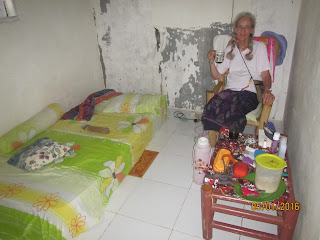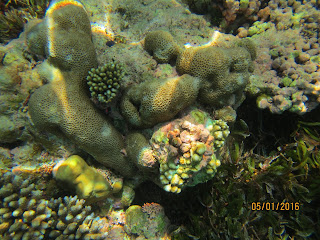Kemarin saya menyarankan seorang teman Indonesia say, kami pergi ke pasar tradisional yang tidak jauh dari kost saya di Kota Mataram, Lombok.
Yesterday I suggested to an Indonesian friend that we go to a traditional market that is not far from my kost in Mataram, Lombok.
Saya suka berkunjung ke tempat seperti itu: itu sebuah tempat yang bagus untuk melihat barang-barang dan kegiatan yang biasa .
I like to go to places like that: it is a good place to see ordinary things and activities.
Saya tidak masak di kost, hanya membuat kopi dan makan kerupuk dan penganan lain, karena makanan di jalan sangat enak; saya juga sering diajak makan dengan teman-teman.
I don’t cook in accommodation, only make coffee and eat chips and other snacks, because street food is very good; also I am often invited to eat with friends.
Oleh karena itu, saya sangka mungkin tidak ingin beli banyak barang di pasar adat itu.
Therefore I thought maybe I would not wish to buy many things from the market.
Akan tetapi, saya didorong oleh penjual-penjual supaya saya membeli hampir lebih daripada saya dapat membawa.
However, I was convinced to buy almost more than I could carry.
Kalau saya berhenti di depan seorang penjual jadi perhatian saya terhadap daganannya jelas kelihatan, penjual itu menjadi sungguh meyakinkan.
If I stop in front of a seller, the seller became so persuasive.
Ada penganan enak untuk makan siang, bungkusan kopi tubruk yang akan membawa ke Australia, piring-piring dan cangkir yang baru untuk kost teman, buah-buahan segar, dan kerupuk.
There was delicious snack for lunch, packets of coffee which I will take to Australia, new plates and a cup for friends’ kost, fresh fruit, and chips.
Saya melihat banyak jenis makanan: tempeh yang berbungkus di bungkusan panjang dan juga tersedia sebagai paket kecil yang bersiap memasak; nangka yang sudah lapisan lengket dihapus; aneka jenis lombok; nanas; tangan-tangan pisang; kol; bawang putih; bawang merah; juga sayur-sayuran yang belum tahu.
I saw very many types of food: tempeh which is wrapped in long packages and also available as small packet ready for cooking; jackfruit whose sticky layer has been removed; various types of chilli; pineapple; hands of bananas; cabbage; garlic; shallots; also vegetables that I don’t know.
Ada peralatan dapur, termasuk sejenis pisau yang kelihatan berbahaya sebab mata pisau dan tangkai diikatkan dengan kawat saja.
There are kitchen tools, including a type of knife which appears dangerous because blade and handle were attached only with wire.
Dikarenakan memakai sarung adat dan berias rambut sebagai jalinan, beberapa penjual menyebut-nyebut tentang penampilan saya.
Because I wear traditional sarong and arrange my hair in plaits, several sellers commented about my appearance.
Sebenarnya, mereka ingin tahu tentang saya, dan bertanya kepada teman saya.
Naturally, they wish to know about me, and ask my friend questions.
Saat kami pergi keluar, ada dua cidomo yang menunggu untuk penumpang.
When we went outside, there were two horse-drawn carts waiting for passengers.
Biasanya rupa cidomo menarik sekali, dengan hiasan berwarna-warna, walaupun warna merah warna yang lebih populer.
Usually the appearance of horse-drawn carts is very attractive, with colourful decorations, though red is the most popular colour.
Cidomo masih sesuatu yang biasa di jalan-jalan Lombok ini sebab ada banyak jalan yang sempit, apalagi di kota Ampenan dan Cakranegara, kotanya yang di setiap sisi Kota Mataram, jadi digunakan oleh orang lokal lebih sering daripada oleh wisatawan.
These horse-drawn carts are still common in streets of Lombok because there are many narrow roads, especially in Ampenan and Cakranegara, the cities on each side of Mataram, so are used by the local people more often than by tourists.
Selain sepeda, cidoma hanya kendaraan yang memperbolehkan di tiga gilinya yang lebih terkenal: Gili Air, Gili Trawangan dan Gili Meno.
Besides bicycles, horse-drawn carts are the only vehicles allowed in the three most famous Gili: Gili Air; Gili Trawangan; Gili Meno.
Kudanya yang digunakan dengan kendaraan ini dipelihara di Pulau Lombok diri.
The horses which are used for these vehicles are bred in Lombok itself.
Pastinya, cidomo adalah kendaraan yang memberikan minat dan warna di jalan-jalannya, tetapi juga berguna untuk orang semuanya, sama dengan pasar tradisional, jadi semoga akan terus terlihat.
Certainly, horse-drawn carts provide interest and colour in the streets, but are also useful for everyone, just like the traditional markets, so I hope will continue to be seen.

























































